Chapter 7: International investment and financing decisions
Chapter learning Objectives
Upon completion of this chapter you will be able to:
- explain the principle of four-way equivalence and the impact on exchange rate fluctuations
- explain the impact of alternative exchange rate assumptions on the value of a project involving overseas cash flows
- forecast project or firm free cash flows in any specified currency
- for an international project use the net present value technique to determine the project’s net present value or firm value under differing exchange rate, fiscal and transaction cost assumptions
- explain and apply the International CAPM equation
- for an international project or firm use the adjusted present value technique to determine the project’s net present value or firm value under differing exchange rate, fiscal and transaction cost assumptions
- evaluate the significance of exchange controls for a given investment decision and strategies for dealing with restricted remittance
- assess the impact of a project upon a firm’s exposure to translation, transaction and economic risk
- describe the costs and benefits of alternative sources of finance available within the international bond and equity markets
- in a scenario question, advise upon the costs and benefits of alternative sources of finance available within the international financial markets.
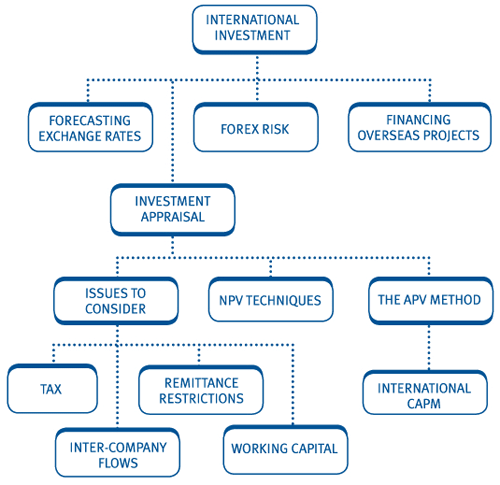
1 Foreign projects and investment appraisal
NPV analysis
The appraisal of projects involving overseas investment, uses thesame NPV model you have used in earlier sessions. It includes basicssuch as:
- identifying relevant cash flows
- calculating a project’s corporation tax liability, including the calculation of tax relief on capital expenditure
- dealing with inflation and distinguishing money and real flows.
However, overseas investment appraisal includes additional challenges:
- Forecasting future exchange rates
- Double taxation.
- Inter-company flows (e.g. management charges or royalties).
- Remittance restrictions.

 Impact of a project on the firm's risk exposure
Impact of a project on the firm's risk exposure
When a firm starts trading in a different country, it is exposed tothree types of risk: transaction, economic and translation risk. Theseterms are defined in detail in Chapter 13.
Undertaking a new, foreign currency, project affects the firm's exposure to these risks as follows:
Transaction risk
Individual receipts and payments which arise during the newproject's life will be subject to transaction risk, in that the value ofthe transactions will initially be calculated using the forecast rateof exchange which may differ from the actual rate on the transactiondate. Firms can use hedging methods (see Chapter 13) to eliminate thistransaction risk.
Economic risk
The project NPV is initially calculated using forecast exchangerates. A change in these forecasts over the life of the project willincrease or decrease the project NPV, and hence the gain toshareholders.
Translation risk
Undertaking a foreign project often involves setting up a foreignbased subsidiary, whose financial statements will have to be translatedback into the home currency for the purposes of group accounting(consolidation). A change in exchange rates from one year to the nextwill cause the value of the subsidiary to fluctuate when its results aretranslated.

2 Forecasting foreign exchange rates
The relationship between interest, inflation, spot and forward rates
The overall relationship between spot rates, interest rates,inflation rates and the forward and expected future spot rates wascovered in Paper F9.
A feature of exam questions covering international investmentdecisions is often the need to calculate the relevant exchange ratesover a number of years, and a summary of the key relationships istherefore given in the four-way equivalence table follows.
Note :
F0 = forward rate
S0 = spot rate
S1 = expected future spot rate
ib = interest rate for base currency
ic = interest rate for counter currency
hb = inflation rate for base currency
hc = inflation rate for counter currency
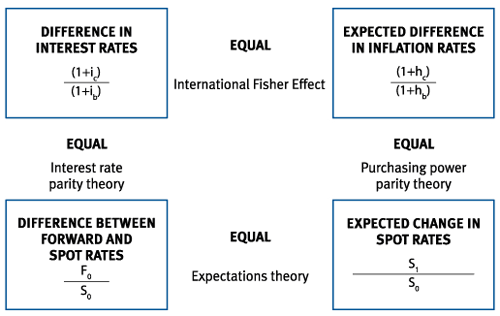

 Illustration of parity calculations
Illustration of parity calculations
The current dollar sterling exchange rate is given as $/£1.7025 – 1.7075.
Expected inflation rates are:
Use the relationships above to work out the expected spot rate for the next three years.
Solution
Using the PPPT formula:


and the mid point of the quoted spread as the exchange rate today:

The calculations for the next three years are:

Note that the exchange rate at the end of one year becomes the basis of the next year’s calculation.


 Test your understanding 1
Test your understanding 1
The current euro sterling exchange rate is given as 1.5274 – 1.5376.
Expected inflation rates are:
Use the relationships above to work out the expected spot rate for the next three years.

Cross rates
You may not be given the exchange rate you need for a particularcurrency, but instead be given the relationship it has with a differentcurrency. You will then need to calculate a cross rate.
For example, if you have a rate in $/£ and a rate in €/£, youcan derive a cross rate for $/€ by dividing the $/£ rate by the€/£ rate.

 Cross rate calculation
Cross rate calculation
A UK company has a Greek subsidiary which is to purchase materialscosting $100,000. The NPV of the overseas cash flows is being calculatedin euros, but you have not been provided with the euro/dollar exchangerate. Instead you have the following information:
What is the value of the purchase in euros?
Solution
The solution could be calculated in two stages:
1. Convert the purchase into sterling:
2. Convert the sterling value into euros
£52,632 × 1.45 = €76,316
However an easier alternative, particularly if there are a number of transactions to convert, is to calculate a cross rate:
The $/€ rate will be 1.90/1.45 = 1.3103
The value of the transaction is therefore:
$100,000/1.3103 = €76,318


 Test your understanding 2
Test your understanding 2
A UK company with an US office has to pay €100,000 for a machine.The NPV of the overseas cash flows is being calculated in dollars.
You have the following information:
What is the cost of the machine in dollars?

Changing inflation rates
When finding exchange rates it might first be necessary to calculate the inflation rates expected in a foreign country.

 Illustration 1
Illustration 1
Inflation is currently 80% in Brazil, although the government hopesto reduce it each year by 25% of the previous year's rate. What willthe inflation rate be in Brazil over the next four years?

You should also comment in your answer that it is unlikely the government will achieve this reduction each year.


 Test your understanding 3
Test your understanding 3
The current rate of inflation in Costovia is 65%.Government action is helping to reduce this rate each year by 10% of theprevious rate. The Costovian peso/dollar rate is currently 142 – 146,and the inflation rate in the US over the next three years is expectedto be 4%, 3.5% and 3% respectively. Find the exchange rate for theCostovian peso against the dollar for the next three years.

3 The impact of taxation, inter company cash flows and remittance restrictions
Taxation
The level of taxation on a project’s profits will depend on therelationship between the tax rates in the home and overseas country.
There are three possible tax scenarios for an exam question.
The home country may have a tax rate that is:
- lower than
- the same as
- higher than the overseas country.
The question will always assume a double-tax treaty ⇒ project always taxed at the highest rate.

 Illustration 2
Illustration 2
What will be the rate of tax on a project carried out in the US by a UK company in each of the following scenarios?
Solution
- Scenario (a) – no further UK tax to pay on the project’s $ profits. Profits taxed at 40% in the US.
- Scenario (b) – no further UK tax to pay on the project’s $ profits. Profits taxed at 33% in the US.
- Scenario (c) – project’s profits would be taxed at 33% : 25% in the US and a further 8% tax payable in the UK.

Inter-company cash flows
Inter-company cash flows, such as transfer prices, royalties and management charges, can also affect the tax computations.
 Although complex in reality, in the exam:
Although complex in reality, in the exam:
- Assume inter-company cash flows are allowable for tax (and state it) unless the question says otherwise
- If an inter-company cash flow is allowable for tax relief overseas, there will be a corresponding tax liability on the income in the home country
- Assume that the tax authorities will only allow ‘arm’s length’/open-market prices for tax relief and will not allow an artificially high or low transfer price.

 Transfer pricing
Transfer pricing
The transfer price is the price charged by one part of a companywhen supplying goods or services to another part of the company, e.g.overseas subsidiary.
Transfer prices are particularly problematical. By manipulating thetransfer prices charged it may be possible to minimise the globaltaxation cost for the group, i.e. to report low profits in countrieswith high taxes and high profits in countries with low rates.
For instance, suppose we have two companies within a group that are based in different countries.
Company A sells components to Company B, whilst B sells marketing services to Company A.
- Company A will report low income therefore limiting its tax charge.
- Company B will be reporting high income as it pays less tax.
By manipulating the transfer price the overall tax charge can belowered. However, the government of country A will not look favourablyon this action.
This objective is therefore frustrated in many countries, as therelevant tax authorities require the transfer price to be set on anarm's length basis, i.e. the market price.
If a question tells you that a company is going to considerablyincrease its transfer price, you could incorporate the new price in yourNPV calculations. However it is essential that you then state in yourreport that the policy may be unsuccessful, as most governments requirethe transfer price to be set on an arm’s length basis, i.e. the marketprice.
Therefore it is preferable, for exam purposes, to assume that thetax authorities will only allow ‘arm’s length’/open-market pricesfor tax relief and will not allow an artificially high or low transferprice.
A second problem may also arise. Although the above may decreasethe taxation, the profits will end up in country B. If the currency ofcountry B is weak relative to the holding company, then loss from thedepreciation of the currency may be more than the tax saving.

The issues of double taxation and the tax treatment of inter-company flows can be shown with an example:

 Illustration 3
Illustration 3
A project carried out by a US subsidiary of a UK company is due toearn revenues of $100m in the US in Year 2 with associated costs of$30m. Royalty payments of $10m will be made by the US subsidiary to theUK. Assume tax is paid at 25% in the US and 33% in the UK; and assume aforecast $/£ spot rate of $1.50/£.
What are the cash flows associated with the project?
Solution
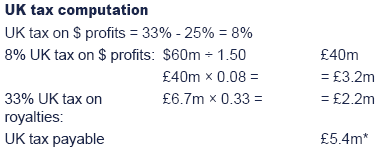

Remittance restrictions
Remittance restrictions occur where an overseas government places alimit on the funds that can be repatriated back to the holding company.This restriction may change the cash flows that are received by theholding company.
 The actual amount received by the parent company (and therefore theshareholders) is the relevant flow for NPV purposes.
The actual amount received by the parent company (and therefore theshareholders) is the relevant flow for NPV purposes.

 Illustration 4
Illustration 4
A project’s after-US tax $ cash flow is as follows ($m):

In any one year, only 50% of cash flows generated can be remittedback to the parent. The blocked funds can be released back to the parentin the year after the end of the project.
Find the cash flows to be evaluated for NPV purposes.
Solution
Cash flows to parent:

It is these remitted cash flows that have to be put through the NPV calculation.
The final cash flows for NPV purposes are therefore:

Working capital
It is a normally assumed that the working capital requirement forthe overseas project will increase by the annual rate of inflation inthat country.

 Working capital calculation
Working capital calculation
Four million pesos in working capital are required immediately for aproject running in South America. The inflation rates for the next sixyears in the South American country are expected to be:

Identify the working capital flows for the NPV calculation:
Solution
All cash flows in $000’s



 Test your understanding 4
Test your understanding 4
Four million pesos are required in working capitalimmediately. The inflation rate in the South American country isexpected to remain constant for the next six years at a rate of 6%.Identify the working capital flows for the NPV calculation, assuming theworking capital is released at t = 7.

4 NPV analysis for foreign projects
There are two methods for calculating the NPV of overseas projects:
The simpler 4-step method is the more conventional one which is used in the majority of cases.

 Test your understanding 5: The standard method for foreign NPV
Test your understanding 5: The standard method for foreign NPV
A manufacturing company based in the United Kingdom is evaluating aninvestment project overseas – in REBMATT a politically stable country.It will cost an initial 5.0 million REBMATT dollars (RM$) and it isexpected to earn post-tax cash flows as follows:

The following information is available:
- Real interest rates in the two countries are the same. They are expected to remain the same for the period of the project.
- The current spot rate is RM$ 2 per £1 Sterling.
- The risk-free rate of interest in REBMATT is 7% and in the UK 9%.
- The company requires a sterling return from this project of 16%.
Calculate the £ Sterling net present value of the project using the standard method i.e. by discounting annual cash flows in £ Sterling.


 The alternative method for foreign NPV
The alternative method for foreign NPV
In the previous Test Your Understanding, the NPV could have been calculated by discounting cashflows in REBMATT $ as follows:
Calculate the adjusted discount rate using the interest rate parity formula:
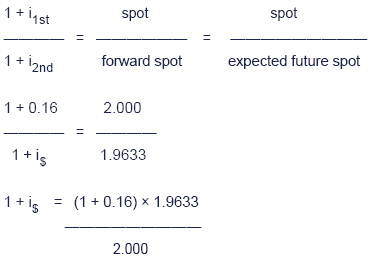
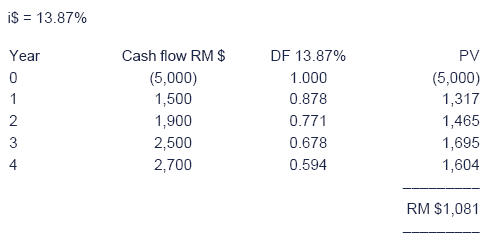
PV = 1,081/2.000 = £541.
The difference between the two results is due to rounding.


 Free cash flows in foreign currency
Free cash flows in foreign currency
In an exam question, you may be told specifically what the foreigncurrency free cashflows are for a new project. Alternatively, you may beexpected to estimate the free cashflows from given accountinginformation. This is covered in more detail in Chapter 10: BusinessValuation, but a simple introductory illustration is shown below.
Illustration of how to estimate free cashflow
Wine Co is considering international expansion by taking over HouseCo, a manufacturing company based in a foreign country (whose currencyis the Foreign Dollar, F$).
According to the most recent accounts of House Co, its turnover andEBIT are F$356m and F$70m respectively. Capital expenditure in the mostrecent year was F$33m and the depreciation charge was F$24m. If Wine Cotakes over House Co, it expects growth in turnover and profitability tobe 3% per annum, and capital expenditure and depreciation to stayconstant. The tax rate in the foreign country is 30% per annum.
The current exchange rate is F$2 = H$1 (H$ is the home currency,the Home Dollar), and this is expected to stay constant for theforseeable future.
Required:
Estimate the free cashflow, in H$, for the first year after the takeover.
Solution
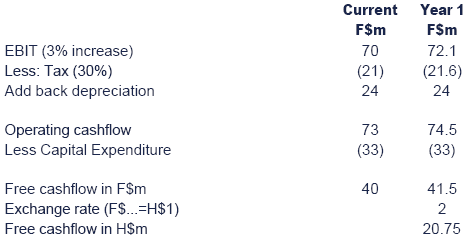

Standard proforma for the conventional approach
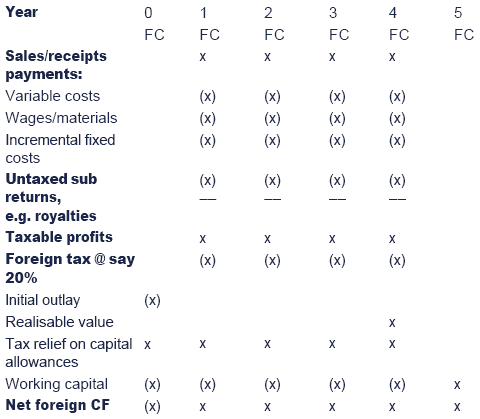
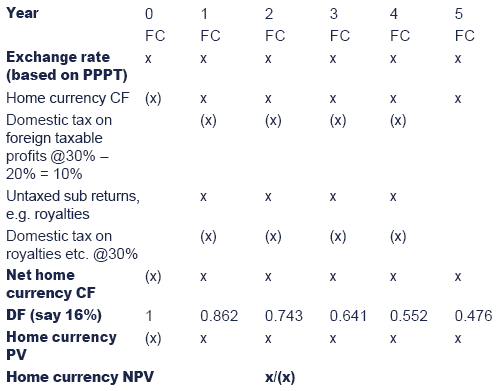
Performing the calculation
It will be necessary to do a number of subsidiary workings in order to reach the final NPV figure, so remember the basic rules:
- Lay out your table clearly and remember you will need one column more than the length of the project if tax is lagged by a year.
- Make sure all workings are clearly referenced.
- State any assumptions and be prepared to comment on them further in any written report that follows.
The following is a guideline order of approach for the conventional approach:
(1) Calculate all the relevant flows in the foreign currency.
(2) If tax is payable on the foreign flows, deduct it.
(3) Convert the net flows into the domestic currency – you may well need to predict future exchange rates to do so.
(4) Consider whether any restrictions are placed on remittances and if so, calculate the cash flows actually received by the parent.
(5) Add any other domestic cash flows to the remitted amounts from overseas.
(6) Discount the total net cash flows in the domestic currency at an appropriate cost of capital.

 Test your understanding 6: Introductory question: foreign NPV
Test your understanding 6: Introductory question: foreign NPV
Parrott Co is a UK based company. It is considering a 3 year project in Farland.
The project will require an initial investment of 81m Farland Florins (FFl) and will have a residual value of 10m FFl.
The project's pre tax net FFl inflows are expected to be:

The UK parent company will charge the overseas project with £2m of management charges each year.
The current spot rate is 5FFl - £1. UK inflation is expected to be4% per annum, and Farland inflation is expected to be 7% per annum.
Farland tax is 20% and is paid immediately. Any losses are carriedforward and netted off the first available profits for tax purposes. Taxallowable depreciation will be granted on a straight line basis, andany residual value will be taxable at 20%. UK tax is 30% and is payable 1year in arrears.
Parrott Co recently undertook a similar risk project in the UK and used 11% as a suitable discount rate.
Required:
Calculate the NPV of the project in £.


 Test your understanding 7: Exam standard question: foreign NPV
Test your understanding 7: Exam standard question: foreign NPV
Puxty Plc is a specialist manufacturer of window frames. Its main UKmanufacturing operation is based in the south of England, from where itdistributes its products throughout the UK.
The directors are now considering whether they should open up anadditional manufacturing operation in France – which they believethere will be a good market for their products.
A suitable factory has been located just outside Paris that couldbe rented on a 5-year lease at an annual charge of €3.8m, payable eachyear in advance. The manufacturing equipment would cost €75m, ofwhich €60m would have to be paid at the start of the project, with thebalance payable 12 months later.
At the start of each year the French factory would require workingcapital equal to 40% of that year’s sales revenues. It is expectedthat the factory will be able to produce and sell 80,000 window unitsper year although, in the first year, because of the need to ‘runin’ the machinery and its new workforce, output is only expected to be50,000 window units. Each window is likely to be sold for €750, aprice that represents a 150% mark-up on cash production costs.
The French factory would be set up as a wholly-owned subsidiary ofPuxty Plc. In France, 25% straight-line depreciation on cost is anallowable expense against company tax. Corporation tax is payable at 40%at each year-end without delay and any unused losses can be broughtforward for set off against the following year’s profits. No UK taxwould be payable on the after-tax French profits.
All amounts in € are given in current terms. Annual inflation inFrench is expected to run at 6% per year in the foreseeable future. AllFF cash flows involved are expected to increase in line with thisinflation rate, with the exception of the factory rental and the cost ofthe manufacturing equipment, both of which would remain unchanged.
The French factory would be producing windows to a special designpatented by Puxty. To protect its patent rights, Puxty Plc will chargeits French subsidiary a fixed royalty of £20 per window. This costwould be allowable against the subsidiary’s French tax liability.
The current €/£ spot rate is 1.5. Inflation in the UK isexpected to be 4% per year over the period. There are no cash flowremittance restrictions between France and the UK.
Puxty Plc is an all-equity financed company that is quoted on theLondon Stock Exchange. Its shares have a beta value of 1.25. The currentannual return on UK Government Treasury Bills is 10% and the expectedreturn on the market is 18%. In the UK Corporation Tax is payable at35%, one year in arrears.
Puxty operates on a 5-year planning horizon. At the end of fiveyears, assume that working capital would be fully recovered and theproduction equipment would have a scrap value, at that time, of €70mbefore tax. Proceeds on asset sales are taxed at 40%. Assume all cashflows arise at the end of the year to which they relate, unlessotherwise stated.
Required:
Evaluate the proposed investment in France andrecommend what investment decision should be made by Puxty plc. Stateclearly any assumptions you make and work all calculations rounded tonearest 10,000 (either € or £) – i.e. €0.01m or £0.01m.


 International CAPM and APV
International CAPM and APV
A recap of the basics
The APV method of investment appraisal was introduced in a previouschapter in the context of domestic investments. There are essentiallythree steps to the technique:
Step 1 Estimate the base case NPV assuming that the project is financed entirely by equity.
Step 2 Estimate the financial “side effects†of the actual method of financing.
Step 3 Add the values from steps 1 and 2 to give the APV.
If the APV is positive, accept the project.
We now examine the applicability of the method in appraising international investments.
Mechanics of the International APV method
The normal procedure of determining the relevant cash flows anddiscounting at a rate of return commensurate with the project’s riskshould be followed as before, but taking account of the internationalfactors as discussed above.
The steps therefore become:
Step 1 The base case NPV assumes that the project isfinanced entirely by equity, so the discount rate must be the cost ofequity allowing for the project risk but excluding financial risk –using the international CAPM equation with an ungeared ‘world’ β (see below).
Step 2 Adjustments should be made for:
- tax relief on debt interest and issue costs
- subsidies from overseas governments
- projects financed by loans raised locally
- restriction on remittances.
Step 3 Add the values from steps 1 and 2 to give the APV.
This is basically the same approach as for domestic appraisal, witha little more care needed in identifying the appropriate appraisalrates and adjustments.
International CAPM
In the domestic context you should recall that the CAPM could be used to derive the return required as
Rj = Rf + β(Rm - Rf)
where Rj is the required return from the investment
Rf is the risk-free rate of return
Rm is the expected return from the whole market
β is a measure of the systematic risk of the investment
However, where a company operates:
- internationally
- in integrated markets
investors should therefore consider applying the international costof capital to investment appraisal, rather than a domestic CAPM.
The logic:
(1) A company involved in international operations, will, in addition to the usual risk, be exposed to:
- currency risk
- political risk.
These are mainly unsystematic and can be diversified away by holding an internationally diversified portfolio.
(2) For example, a fullydiversified UK investor can achieve further risk reduction by investingin other countries. Part of the systematic risk of the UK market is infact unsystematic risk from an international viewpoint.
The international CAPM equation will therefore read:
Rj = Rf + βw (Rw – Rf)
where
Rj is the required return
Rw is the expected return from the whole world portfolio
βw is a measure of the project’s world systematicrisk, i.e. how returns on the investment correlate with those on theworld market.
In the UK, for example, the return from the whole market could beestimated from looking at domestic stock market indexes such as the FTSEActuaries All-Share index, which covers about 700 of the top shareslisted in the UK.
This basic CAPM model is valid for:
- a company or investor with domestic investments only, or
- investments in a country with segmented markets, as opposed to integrated markets.
Integrated capital markets exist if investors can invest in anycountry that does not impose restrictions on capital movements.Segmented markets are associated with a closed economy, or markets whereswitching investments from country to country is not easily achieved,such as in many service industries.
It is argued that:
Investors can diversify their risk more effectively in anintegrated market, because more investments are available and returns ondomestic and foreign assets are not perfectly correlated.
The cost of capital is lower if markets are integrated than in aclosed economy. Companies whose shareholders are international investorsshould therefore consider applying the international cost of capital toinvestment appraisal, rather than a domestic CAPM.
This can be done by looking at the international CAPM.
In practice it is impossible to hold a share of the whole worldportfolio, but significant international diversification can be achievedby:
- direct holdings in overseas companies
- holdings in unit trusts specialising in overseas companies
- investing in multinational companies.
You should appreciate that in principle risk reduction can beachieved either by investing directly in an international portfolio ofshares or investing in local companies with significant overseasactivities.
Implications of the international capital asset pricing model (or IAPM) are that:
When setting a cost of capital, a company should assess the nature of its investors and their investment portfolios.
If markets are segmented, investments that are profitable for aninternational/foreign company might not be profitable for a domesticcompany, because the international company will have a lower cost ofcapital.
However, the validity of the international capital asset pricingmodel rests on the assumption that capital markets are fully integratedand investors are ‘world’ investors. In practice, this is notnecessarily the case. Countries and capital markets are not fullyintegrated, since there are costs to foreign investment and domesticinvestors often have better access to information than foreigninvestors.
In conclusion, although the international capital asset pricingmodel can in theory be applied, there remain valid reasons for measuringthe cost of equity on the basis of a domestic market portfolio and thebasic CAPM.

5 Financing foreign projects
A firm planning to invest overseas may choose to raise the finance required in the international financial markets.
There is a variety of sources of finance available:
Short-term funding:
- Eurocurrency loans.
- Syndicated loans.
- Short-term syndicated credit facilities.
- Multiple option facilities.
- Euronotes.
Long-term funding:
- Syndicated loans
- Eurobonds.
Eurocurrency loans
Multinational companies and large companies, which are heavilyengaged in international transactions, may require funds in a foreigncurrency.
A Eurocurrency loan is a loan by a bank to a company denominated incurrency of a country other than that in which they are based.
e.g. A UK company acquiring a dollar loan from a UK bank operating in the Eurocurrency market has acquired a Eurodollar loan.
Loans can take a variety of forms:
- Straight loans.
- Lines of credit.
- Revolving loans.
Borrowers looking to eurocurrency loans must have first class credit ratings and wish to deal in large sums of money.
A variety of factors will influence the decision over whether toborrow in the domestic currency or in a foreign currency. The mostimportant are:
- the currency required
- cost and convenience
- the size of loans.

 More on eurocurrency loans
More on eurocurrency loans
The currency required
Companies may have needs for foreign currency funds for eithertrading or financing purposes and the Eurocurrency market may be a moreconvenient or cheaper source of such funds than in the domestic marketof the country whose currency is needed..
Cost and convenience
Eurocurrency loans may be:
A cheaper if interest rates are lower; even if interest rate differentials are small this may be significant for large loans
B quicker to arrange
C unsecured and large companies can rely on their credit ratings rather than the security that can offer.
The size of loans
The Eurocurrency markets hold very large funds and for companieswishing to obtain very large loans this may be a viable alternative todomestic banking sources.

As well as a conventional Eurocurrency loans, the internationalmoney markets have developed alternative short-term credit instruments.
Syndicated loans
For large loans a single bank may not be willing (due to risk exposure) or able to lend the whole amount.
A syndicated loan is a loan made to a borrower by two or moreparticipants but is governed by a single loan agreement. The loan isstructured by an arranger and each syndicate participant contributes adefined percentage of the loan and receives the same percentage of therepayments.
The syndicated loan market is made up of international lenders andwas originally limited to global firms for acquisitions and other majorinvestments. This is for the following reasons:
- Cost – being international, loans can often be raised avoiding national regulation and are thus cheaper.
- Speed – the market is very efficient so large loans can often be put together quickly if necessary.
- By diversifying lending sources borrowers may be able to eliminate foreign exchange rate risk.
However, the market has expanded rapidly with smaller and mediumsized firms borrowing funds – syndicated loans as small as $10 millionare now commonplace.
Syndicated credits
Similar to syndicated loans, syndicated credits allow a borrower toborrow funds when it requires, but can choose not take up the fullamount of the agreed facility. These are expensive funds used commonly:
- to fund takeovers
- to refinance debts incurred during a takeover.
Multiple option facilities
Recently developed financial instruments, these are designed to give the borrower a choice of available funds.
Commonly this will combine:
- a panel of banks to provide a credit standby at a rate of interest linked to LIBOR
- another panel of banks to bid to provide loans when the borrower needs cash.
These funds can be in a variety of forms and denominated in a variety of currencies.
Euronotes
Euronotes have the following features:
- Firms issue promissory notes which promise to pay the holder a fixed sum of money on a specific date or range of dates in the future.
- The Eurobond market acts as both a primary and secondary market often underwritten by banks through revolving underwriting facilities.
- Can be are short or medium term issued in single or multiple currencies. The medium-term notes bridge the gap between the short-term issues and the longer-term Eurobonds.
Eurobonds
The most important source of longer term funding is the Eurobond.
Eurobonds are:
- long term (3–20 years)
- issued and sold internationally
- denominated in a single currency
- fixed or floating interest rate bonds.
They are suitable for organisations that require:
- large capital sums for long periods
- borrowing not subject to domestic regulations.
However, a currency risk may arise if the investment the bonds arefunding generates net revenues in a currency different from that thebond is denominated in.

 More details on Eurobonds
More details on Eurobonds
In addition to short-term credit, companies and government bodiesmay wish to raise long-term capital. For this there is an internationalcapital market corresponding to the international money market butdealing in longer-term funding with a different range of financialinstruments. The most important of these is the Eurobond.
Eurobonds are long-term loans, usually between 3 and 20 yearsduration, issued and sold internationally and denominated in a singlecurrency, often not that of the country of origin of the borrower. Theymay be fixed or floating interest rate bonds. The latter were introducedsince inflation, especially if unpredictable, made fixed rate bondsless attractive to potential borrowers.
Eurobonds are suitable sources of finance for organisations that require:
- large capital sums for long periods, e.g. to finance major capital investment programmes
- borrowing not subject to domestic regulations especially exchange controls which may limit their ability to export capital sums.
However, Eurobonds involves the borrower in currency risk. If thecapital investment generates revenue in a currency other than that inwhich the bond is denominated and exchange rates change the borrowerwill:
- suffer losses if the currency in which the bond is denominated strengthens against the currency in which the revenues are denominated
- make gains if the currency in which the bond is denominated weakens against the currency in which the revenues are denominated.


 Detailed example
Detailed example
Assume that ‘now’ is June 20X3.
Question part (a)
Somax plc wishes to raise 260 million Swiss francs in floating ratefinance for a period of five years. Discuss the advantages anddisadvantages of raising such funds through:
(1) Direct borrowing from adomestic banking system such as the Swiss domestic banking system.(Detailed knowledge of the Swiss banking system is not required.)
(2) The Euromarket.
Question part (b)
The funds are to be used to establish a new production plant inSwitzerland. Somax evaluates its investments using NPV, but is not surewhat cost of capital to use in the discounting process.
The company is also proposing to increase its equity finance in thenear future for UK expansion, resulting overall in little change in thecompany’s market weighted capital gearing. The summarised financialdata for the company before the expansion are shown below:
Income statement for the year ending 31 March 20X3.

Balance sheet (statement of financial position) as at 31 March 20X3

Shareholders’ funds

1 Including £75m 14% fixed rate bonds due to mature infive years time and redeemable at £100. The current market price ofthese bonds is £119.50. Other medium and long-term loans are floatingrate UK bank loans at bank base rate plus 1%.
Corporate tax may be assumed to be at the rate of 33% in both the UK and Switzerland.
The company’s ordinary shares are currently trading at 376 pence.
Somax’s equity beta is estimated to be 1.18. The systematic risk of debt may be assumed to be zero.
The risk free rate is 7.75% and market return 14.5%. Bank base rate is currently 8.25%.
The estimated equity beta of the main Swiss competitor in the sameindustry as the new proposed plant in Switzerland is 1.5, and thecompetitor’s capital gearing is 35% equity, 65% debt by book values,and 60% equity, 40% debt by market values.
Somax can borrow in Swiss francs at a floating rate of between5.75% and 6% depending upon which form of borrowing is selected (i.e. inthe Euromarkets or the Swiss domestic market).
SFr LIBOR is currently 5%.
The interest rate parity theorem may be assumed to hold.
Required:
Estimate the STERLING cost of capital that Somax should use asthe discount rate for its proposed investment in Switzerland. Stateclearly any assumptions that you make.
Solution
(a) Tutorial note: The rates in this question might seem unusual, but you should answer the question on the basis of the data provided.
SFr260 million is approximately £110 million. This is a largesum to borrow from an individual bank. The largest domestic Swiss bankscould handle individual loans of this size, but it is possible that theloan would be arranged through several Swiss banks, which spreads thedefault risk between them.
Domestic banking systems are normally subject to moreregulation and reserve requirements than the Euromarkets, leading towider spreads between borrowing and lending rates. The cost of borrowingon domestic markets is often slightly more expensive than theEuromarkets, and may involve fixed or floating charges on corporateassets as security for loans. Few Euromarket loans require security.Domestic market loans may be either fixed or floating rate, but bankloans are more likely to be at a floating rate.
If Euromarkets are used the main choices are:
(1) Eurocurrency loans from the international banking system.
(2) The issue of securities direct to the market by Somax.
A five year loan is quite long for the Eurocurrency market,which specialises in short to medium-term loans. Large loans can beraised quickly at little issue cost, often through investment syndicatesof banks. However, medium-term to long-term international bank loansmay be arranged by individual banks or syndicates of banks. Interest onthese types of loan is normally floating rate, at SFr LIBOR plus apercentage dependent upon Somax’s credit rating. Draw-down dates areoften flexible, but commitment fees may be payable if the full amount ofthe loan is not drawn down immediately, and early redemption penaltiesare normal.
An argument in favour of using the banking system, whetherdomestic or international is that banks are specialists in analysing andmonitoring debts. If large loans are agreed by banks this is a sign ofgood credit standing, and may facilitate access to cheaper funds onother capital markets.
Somax has a number of choices of issuing securities on theEuromarket. The Euronote market involves short to medium-term issue ofpaper such as Euro-commercial paper and Euro-medium term notes. Banks,for a fee, will arrange such issues and may underwrite their success.
Eurobonds (international bonds) are medium to long-term bondssold in countries other than the country of the currency in which theissue is denominated. Both the eurobond and euronote market provide theopportunity to borrow either fixed or floating rate finance, dependingupon which financial instrument is selected although most bond and noteissues are at a fixed coupon.
Some eurobonds may be convertible or have warrants attachedwhich can offer attractions to both issuers and investors. Adisadvantage of the eurobond market is that issue costs are higher thanthe eurocurrency market, and it takes longer to arrange a eurobondissue. In addition, only very large companies with a good credit ratingare likely to issue bonds successfully in the European market. The mainadvantage of issuing bonds, notes or commercial paper on the euromarketis that funds may normally be raised at a lower interest cost thanborrowing from the domestic or international banking system.
(b) The discount rate should be aweighted average cost of capital, which takes into account thesystematic risk of the new investment.
Cost of equity
Somax proposes to establish a new production plant inSwitzerland. As this involves diversifying into a new industry, thecompany’s existing equity beta is unlikely to reflect the systematicrisk of the new investment. The project systematic risk may be estimatedusing the equity beta of the main Swiss competitor after allowing fordifferences in capital structure (financial risk) between the twocompanies.
Ungearing the equity beta of the Swiss competitor (using market values):

The asset beta must be re-geared to reflect the capital structure of Somax. Using market values:

Using CAPM, the cost of equity is:
Ke = Rf + (Rm – Rf)βe
Ke = 7.75% + (14.5% – 7.75%) 1.129 = 15.37%.
Cost of debt
Somax is considering the use of two alternative forms of SFrfloating rate financing which involved differing interest costs, varyingfrom 5.75% to 6%. Issuing securities on the Euromarket would normallybe slightly cheaper than borrowing directly from international banks. Itis assumed that the 5.75% rate refers to Euromarket borrowing.
Using interest rate parity we can derive the effective interest rates in sterling terms:

Using mid rate exchange rates, and taking the Swiss rate of 5.75% per annum initially:

so i£ = 4.18% from the formula (a 6 monthly rate), which corresponds to an annual rate of 8.36%.
(Similarly, using the Swiss rate of 6% would give an effective sterling rate of 8.60%.)
WACC
Note that gearing levels are not expected to change the estimated weighted average cost of capital is:
(15.37% × 1,692 + 8.36% (1 – 0.33) 224.63)/(1,692 + 224.63)
= 14.23% or (14.24% using the 8.60% cost of debt).

6 Chapter summary
Test your understanding answers

 Test your understanding 1
Test your understanding 1
Using the formula:

and the midpoint of the quoted spread as the exchange rate today:
1.5274 + (1.5376 – 1.5274)/2 = 1.5325
The calculations for the next three years are:
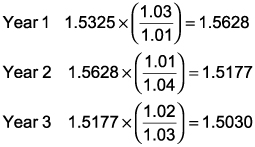


 Test your understanding 2
Test your understanding 2
The €/$ cross rate will be calculated as:
1.53/1.87 = 0.8182
The cost of the machine is therefore:
€100,000 / 0.8182 = $122,220


 Test your understanding 3
Test your understanding 3
Step 1 – find the inflation rate in Costovia over the next three years:

Step 2 – find the exchange rates:
Using the formula:

expand the midpoint of the quoted spread as the exchange rate today:
142 + (146 – 142)/2 = 144
The calculations for the next three years are:
Year 1 144 × (1.585/1.04) = 220
Year 2 220 × (1.527/1.035) = 325
Year 3 325 × (1.474/1.03 ) = 465


 Test your understanding 4
Test your understanding 4


 Test your understanding 5: The standard method for foreign NPV
Test your understanding 5: The standard method for foreign NPV
Calculation of exchange rates
Using the interest rate parity theory:

NPV = £542


 Test your understanding 6: Introductory question: foreign NPV
Test your understanding 6: Introductory question: foreign NPV
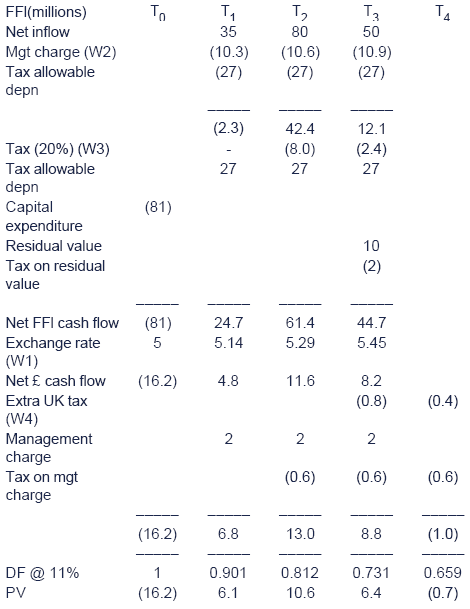
So, NPV = £6.2m, so accept the project.
Workings:
W1 Exchange rates
Using Purchasing Power Parity,
future exchange rate = spot × (1.07 / 1.04)
Year 1 rate = 5 × (1.07 / 1.04) = 5.14
Year 2 rate = 5.14 × (1.07 / 1.04) = 5.29
Year 3 rate = 5.29 × (1.07 / 1.04) = 5.45
W2 Management charges
Convert into FFl using the exchange rates from W1 above.
Year 1: £2m × 5.14 = 10.3m FFl
Year 2: £2m × 5.29 = 10.6m FFl
Year 3: £2m × 5.45 = 10.9m FFl
W3 Farland tax
Tax is 20% in the same year.
However, the loss of 2.3m FFl in year 1 is carried forward andnetted off the profit of 42.4m FFl in year 2 to give year 2 tax of 20%× (42.4 - 2.3) = 8.0m FFl
W4 UK tax
From W3 above, the taxable profit in year 2 is 42.4 - 2.3 = 40.1mFFl. At the year 2 exchange rate of 5.29 (W1) this amounts to £7.6m.
Hence, the extra UK tax payable is 10% × £7.6m = £0.8m, one year later (in year 3).
The taxable profit in year 3 is 12.1m + 10m (residual value) =22.1m FFl. At the year 3 exchange rate of 5.45 (W1) this amounts to£4.1m.
Hence the extra UK tax payable is 10% × £4.1m = £0.4m, one year later (in year 4).


 Test your understanding 7: Exam standard question: foreign NPV
Test your understanding 7: Exam standard question: foreign NPV
Solution
Cash flow analysis (€m)
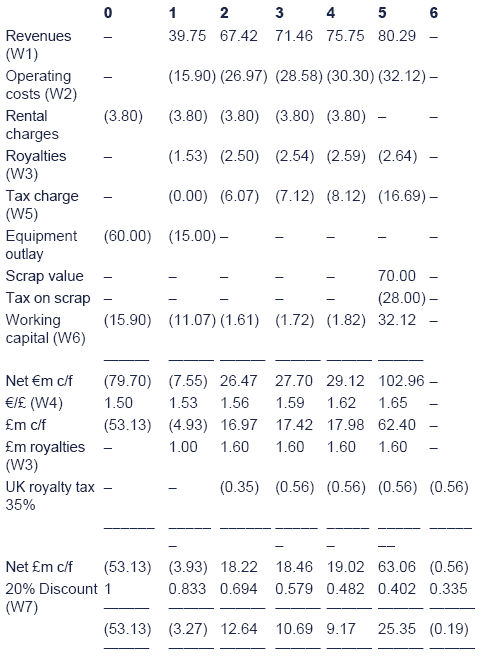
NPV: + £1.26m.
W1 €m Sales revenues
50,000 × 750 (1.06) = 39.75 Year 1
80,000 × 750 (1.06)2 = 67.42 Year 2
80,000 × 750 (1.06)3 = 71.46 Year 3
80,000 × 750 (1.06)4 = 75.75 Year 4
80,000 × 750 (1.06)5 = 80.29 Year 5
W2 €m Production costs
39.75 ÷ 2.5 = 15.9 Year 1
67.42 ÷ 2.5 = 26.97 Year 2
71.46 ÷ 2.5 = 28.58 Year 3
75.75 ÷ 2.5 = 30.30 Year 4
80.29 ÷ 2.5 = 32.12 Year 5
W3 €m Royalty payments
50,000 × £20 = £1m × 1.53 = €1.53m = Year 1 (exchange rate calculations – see W4).
80,000 × £20 = £1.6m × 1.56 = €2.50m = Year 2
80,000 × £20 = £1.6m × 1.59 = €2.54m = Year 3
80,000 × £20 = £1.6m × 1.62 = €2.59m = Year 4
80,000 × £20 = £1.6m × 1.65 = €2.64m = Year 5
W4 €/£ Exchange rate
W5 Basic €m tax calculations
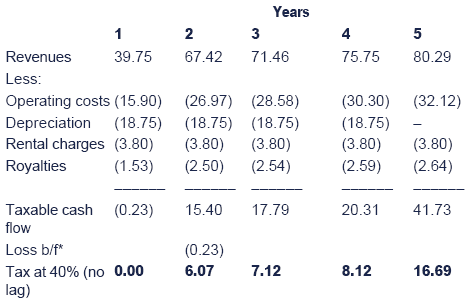
- No other business in France means no profits available to set offthe loss in that year. Instead it is carried forward for set off in thefollowing year.
W6 €m Working capital requirement
Revenue × 40% Needed – Previous balance = Injection
39.75 × 0.4 = 15.90 – 0 = 15.90 Year 0
67.42 × 0.4 = 26.97 – 15.90 = 11.07 Year 1
71.46 × 0.4 = 28.58 – 26.97 = 1.61 Year 2
75.75 × 0.4 = 30.30 – 28.58 = 1.72 Year 3
80.29 × 0.4 = 32.12 – 30.30 = 1.82 Year 4
Recovery 32.12 Year 5
W7 £ discount rate
Using the CAPM equation:
Rj = Rf + β(Rm - Rf)
The discount rate can be found as: 10% + (18% – 10%) × 1.25 = 20%.
Conclusion
As the French manufacturing project generates a positive NPV itshould be undertaken, provided the directors are happy with theestimates they have made.
Assumptions
Royalties are allowable against French tax.
Royalties are subject to UK tax.
Further information that might be useful to the analysis would include:
- Details as to how the estimates of the project’s cash flows were made.
- Details about where the company derived its estimate of the future French inflation rate and the future rate of depreciation of the French franc.
- Details of how the estimate of the machinery’s five-year scrap value was made.
- An analysis about whether or not country risk might be a significant factor.
- How sensitive is the NPV calculation to changes in some of the key estimates.

|
Created at 5/24/2012 3:53 PM by System Account
(GMT) Greenwich Mean Time : Dublin, Edinburgh, Lisbon, London
|
Last modified at 5/25/2012 12:55 PM by System Account
(GMT) Greenwich Mean Time : Dublin, Edinburgh, Lisbon, London
|
|
|
|
 |
Rating
:
|
 Ratings & Comments
(Click the stars to rate the page) Ratings & Comments
(Click the stars to rate the page)
|
 |
Tags:
|
|
|
|
|